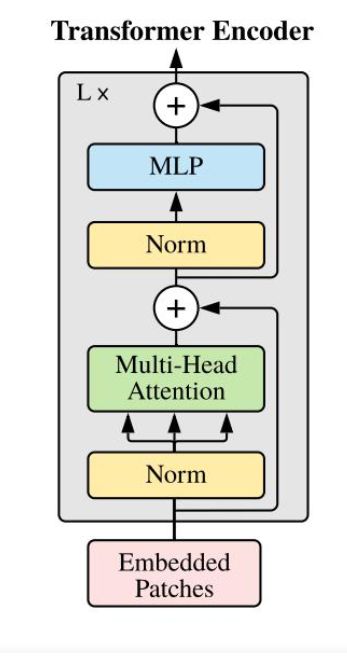VIT 源码详解
1.项目配置说明
参数说明:
数据集:
--name cifar10-100_500
--dataset cifar10
哪个版本的模型:
--model_type ViT-B_16
预训练权重:
--pretrained_dir checkpoint/ViT-B_16.npz
2.patch embeding与position_embedding
对于图像编码,以VIT - B/16为例,首先用卷积核大小为16*16、步长为16的卷积,对图像进行变换,此时图像维度变成16 * 768 * 14 * 14,再变换维度为[16, 196, 768],然后将维度为16*1*768的0patch相连。
对于位置编码,构建一个1 * 197 * 768的向量
最后,将图像编码与位置编码相加就完成了本次编码。
代码如下:
class Embeddings(nn.Module):
"""Construct the embeddings from patch, position embeddings.
"""
def __init__(self, config, img_size, in_channels=3):
super(Embeddings, self).__init__()
self.hybrid = None
img_size = _pair(img_size)
# patch_size 大小 与 patch数量 n_patches
if config.patches.get("grid") is not None:
grid_size = config.patches["grid"]
patch_size = (img_size[0] // 16 // grid_size[0], img_size[1] // 16 // grid_size[1])
n_patches = (img_size[0] // 16) * (img_size[1] // 16)
self.hybrid = True
else:
patch_size = _pair(config.patches["size"])
n_patches = (img_size[0] // patch_size[0]) * (img_size[1] // patch_size[1])
self.hybrid = False
# 使用混合模型
if self.hybrid:
self.hybrid_model = ResNetV2(block_units=config.resnet.num_layers,
width_factor=config.resnet.width_factor)
in_channels = self.hybrid_model.width * 16
# patch_embeding 16 * 768 * 14 * 14
self.patch_embeddings = Conv2d(in_channels=in_channels,
out_channels=config.hidden_size,
kernel_size=patch_size,
stride=patch_size)
# 初始化 position_embeddings: 1 * 197 * 768
self.position_embeddings = nn.Parameter(torch.zeros(1, n_patches+1, config.hidden_size))
# 初始化第 0 个patch,表示分类特征 1*1*768
self.cls_token = nn.Parameter(torch.zeros(1, 1, config.hidden_size))
# dropout层
self.dropout = Dropout(config.transformer["dropout_rate"])
def forward(self, x):
print(x.shape)
B = x.shape[0]
# 拓展cls_tokens的维度:16 *1*768
cls_tokens = self.cls_token.expand(B, -1, -1)
print(cls_tokens.shape)
# 混合模型
if self.hybrid:
x = self.hybrid_model(x)
# 编码:16 * 768 * 14 * 14
x = self.patch_embeddings(x)
print(x.shape)
# 变换维度:16 * 768 * 14 * 14-->[16, 768, 196]
x = x.flatten(2)
print(x.shape)
# [16, 768, 196] --> [16, 196, 768]
x = x.transpose(-1, -2)
print(x.shape)
# 加入分类特征patch
x = torch.cat((cls_tokens, x), dim=1)
print(x.shape)
# 加入位置编码
embeddings = x + self.position_embeddings
print(embeddings.shape)
# dropout层
embeddings = self.dropout(embeddings)
print(embeddings.shape)
return embeddings3.ecoder
多头注意力模块:
首先构建q,k,v三个辅助向量,因为我们采用多头注意力机制(12个),首先,我们需要将q,k,v维度从16, 197, 768转换成16, 12, 197, 64,然后获得q,k的相似性qk,因为获得的是两两之间的关系,所以维度为16, 12, 197, 197,消除量纲,经过softmax后,得到提取到的特征向量qkv,维度为16, 12, 197, 64,再将维度还原成16, 197, 768
class Attention(nn.Module):
def __init__(self, config, vis):
super(Attention, self).__init__()
self.vis = vis
# heads数量
self.num_attention_heads = config.transformer["num_heads"]
# 每个head的向量维度
self.attention_head_size = int(config.hidden_size / self.num_attention_heads)
# 总head_size
self.all_head_size = self.num_attention_heads * self.attention_head_size
# query向量
self.query = Linear(config.hidden_size, self.all_head_size)
# key向量
self.key = Linear(config.hidden_size, self.all_head_size)
# value向量
self.value = Linear(config.hidden_size, self.all_head_size)
# 全连接层
self.out = Linear(config.hidden_size, config.hidden_size)
# dropout层
self.attn_dropout = Dropout(config.transformer["attention_dropout_rate"])
self.proj_dropout = Dropout(config.transformer["attention_dropout_rate"])
self.softmax = Softmax(dim=-1)
def transpose_for_scores(self, x):
# 维度:16, 197, 768-->16,197,12,64
new_x_shape = x.size()[:-1] + (self.num_attention_heads, self.attention_head_size)
# print(new_x_shape)
x = x.view(*new_x_shape)
# print(x.shape)
# print(x.permute(0, 2, 1, 3).shape)
# 16,197,12,64 --> 16, 12, 197, 64
return x.permute(0, 2, 1, 3)
def forward(self, hidden_states):
# print(hidden_states.shape)
# q,k,v:16, 197, 768
mixed_query_layer = self.query(hidden_states)
# print(mixed_query_layer.shape)
mixed_key_layer = self.key(hidden_states)
# print(mixed_key_layer.shape)
mixed_value_layer = self.value(hidden_states)
# print(mixed_value_layer.shape)
# q,k,v:16, 197, 768-->16, 12, 197, 64
query_layer = self.transpose_for_scores(mixed_query_layer)
# print(query_layer.shape)
key_layer = self.transpose_for_scores(mixed_key_layer)
# print(key_layer.shape)
value_layer = self.transpose_for_scores(mixed_value_layer)
# print(value_layer.shape)
# q,k的相似性:16, 12, 197, 197
attention_scores = torch.matmul(query_layer, key_layer.transpose(-1, -2))
# print(attention_scores.shape)
# 消除量纲
attention_scores = attention_scores / math.sqrt(self.attention_head_size)
# print(attention_scores.shape)
attention_probs = self.softmax(attention_scores)
# print(attention_probs.shape)
weights = attention_probs if self.vis else None
attention_probs = self.attn_dropout(attention_probs)
# print(attention_probs.shape)
# print(value_layer.shape)
# 特征向量:qkv:16, 12, 197, 64
context_layer = torch.matmul(attention_probs, value_layer)
# print(context_layer.shape)
# 16, 12, 197, 64-->16, 12, 197, 64
context_layer = context_layer.permute(0, 2, 1, 3).contiguous()
# print(context_layer.shape)
# 16, 12, 197, 64-->16, 197, 768
new_context_layer_shape = context_layer.size()[:-2] + (self.all_head_size,)
context_layer = context_layer.view(*new_context_layer_shape)
# print(context_layer.shape)
# 全连接层:16, 197, 768
attention_output = self.out(context_layer)
# print(attention_output.shape)
# dropout层
attention_output = self.proj_dropout(attention_output)
# print(attention_output.shape)
return attention_output, weightstransformer encoder
对于输入的x,首先经过层归一化后,输入多头注意力机制,对结果进行残差连接,再经过层归一化,经过两层全连接,残差连接后,得到一个模块结果,堆叠L层,输出最终结果
class Block(nn.Module):
def __init__(self, config, vis):
super(Block, self).__init__()
# 序列的大小:768
self.hidden_size = config.hidden_size
# 层归一化
self.attention_norm = LayerNorm(config.hidden_size, eps=1e-6)
self.ffn_norm = LayerNorm(config.hidden_size, eps=1e-6)
# MLP层
self.ffn = Mlp(config)
# 多头注意力机制
self.attn = Attention(config, vis)
def forward(self, x):
# print(x.shape)
# 16, 197, 768
h = x
# 层归一化
x = self.attention_norm(x)
# print(x.shape)
# 多头注意力机制
x, weights = self.attn(x)
# 残差连接
x = x + h
# print(x.shape)
h = x
# 层归一化
x = self.ffn_norm(x)
# print(x.shape)
# MLP层
x = self.ffn(x)
# print(x.shape)
# 残差连接
x = x + h
# print(x.shape)
return x, weights整体架构
对于输入x,进行patch embeding和position embeding后,此时维度为16*197*768,输入encoder中,经过L层的编码模块,取出第0个patch的编码结果(表示分类特征),输入分类层,得到预测结果。
class VisionTransformer(nn.Module):
def __init__(self, config, img_size=224, num_classes=21843, zero_head=False, vis=False):
super(VisionTransformer, self).__init__()
self.num_classes = num_classes
self.zero_head = zero_head
self.classifier = config.classifier
self.transformer = Transformer(config, img_size, vis)
self.head = Linear(config.hidden_size, num_classes)
def forward(self, x, labels=None):
x, attn_weights = self.transformer(x)
print(x.shape)
# X.shape:16, 197, 768 logits.shape:16, 10
logits = self.head(x[:, 0])
print(logits.shape)
# 交叉熵
if labels is not None:
loss_fct = CrossEntropyLoss()
loss = loss_fct(logits.view(-1, self.num_classes), labels.view(-1))
return loss
else:
return logits, attn_weights
